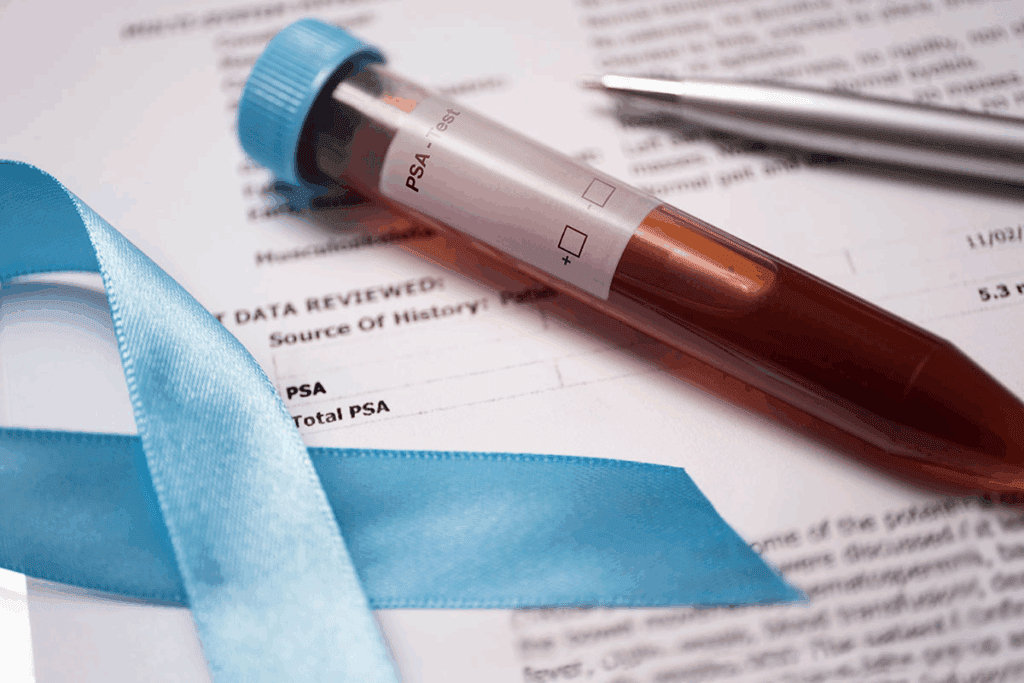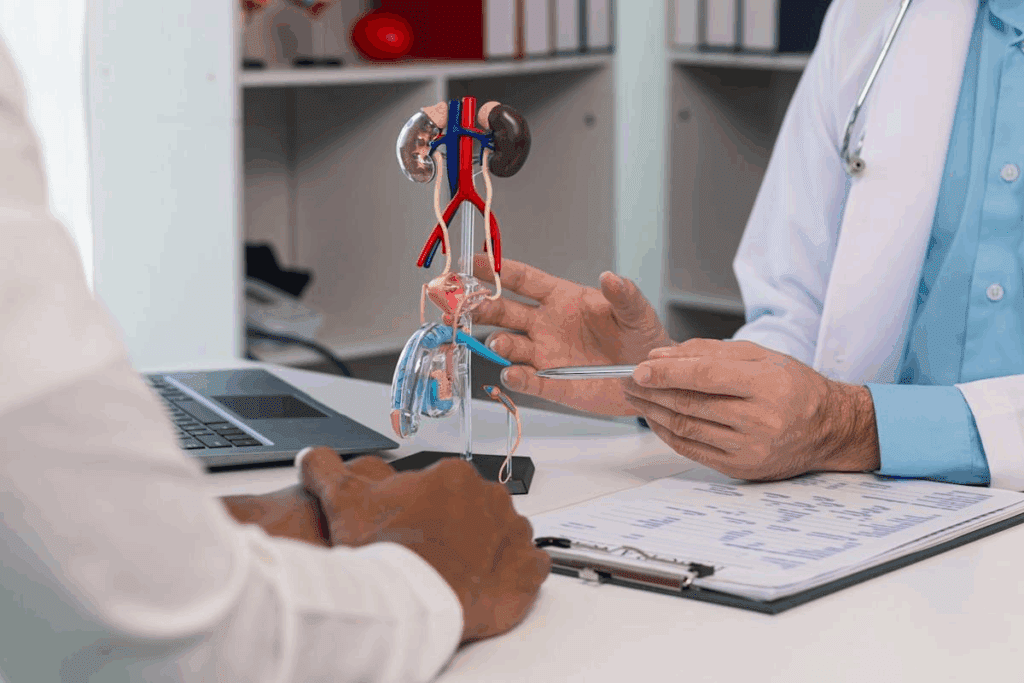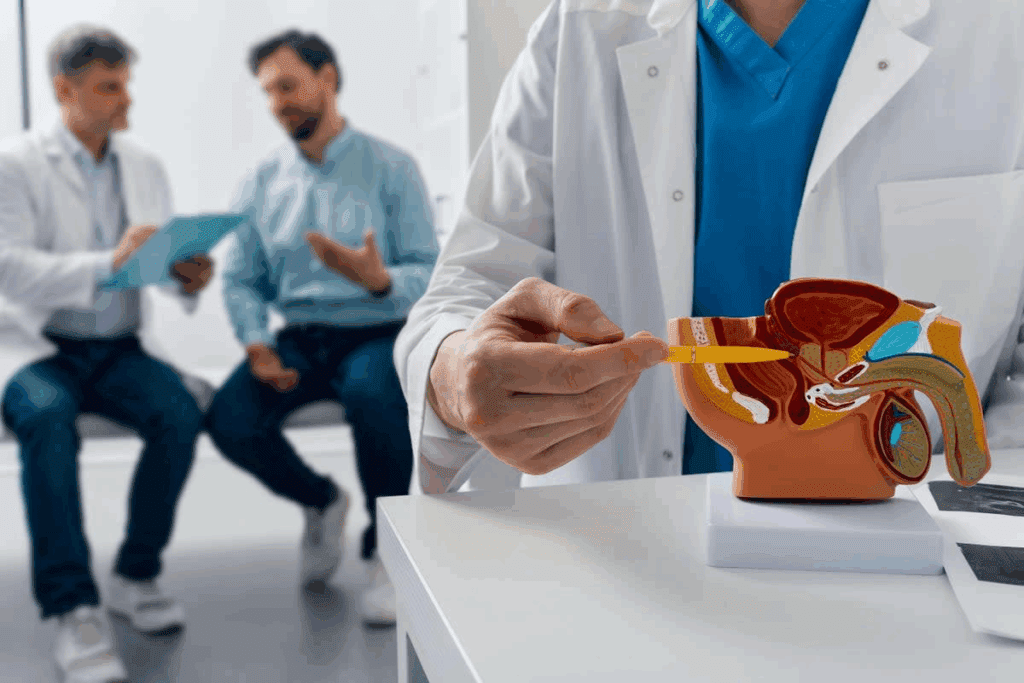Last Updated on November 25, 2025 by Ugurkan Demir

For patients on androgen deprivation therapy (ADT), knowing the side effects is key. At Liv Hospital, we offer full support during your prostate cancer treatment. We know that over 80 percent of patients face issues like hot flushes, tiredness, and changes in sex life.
Learn about prostate cancer treatment hormone therapy side effects and how they impact patients.
Hormone therapy is a common prostate cancer treatment. It lowers testosterone levels or blocks its impact on cancer cells. Though it’s effective, it can cause different side effects. Understanding these and how to handle them helps patients keep their quality of life.

Hormone therapy is key in treating prostate cancer. It’s important for both patients and doctors to understand how it works. Prostate cancer grows because of male hormones, like testosterone. Therapy aims to lower these hormones or block their effect on cancer cells.
Androgen Deprivation Therapy (ADT) is a hormone treatment for prostate cancer. It lowers male hormones in the body or blocks them from reaching cancer cells. This is vital because male hormones can make cancer cells grow.
ADT can be done through medicine or surgery, depending on the cancer stage and patient health. The goal is to slow or stop cancer cell growth.
Hormone therapy stops cancer cells from growing by cutting off their hormone supply. It reduces androgen levels, helping to:
The success of hormone therapy varies by case and treatment type. Some see big benefits, while others might need more treatments.
| Therapy Type | Mechanism of Action | Common Side Effects |
| LHRH Agonists | Initially stimulate, then suppress androgen production | Hot flashes, fatigue, erectile dysfunction |
| LHRH Antagonists | Immediately suppress androgen production | Hot flashes, injection site reactions |
| Androgen Receptor Blockers | Block androgen receptors on cancer cells | Fatigue, hot flashes, gynecomastia |

Hormone therapy medications for prostate cancer are divided into several types. They are important for managing prostate cancer. They either reduce testosterone production or block its effects on cancer cells.
LHRH agonists are a type of hormone therapy. They first increase testosterone production. But, with ongoing use, they lower LH and FSH production. This leads to a decrease in testosterone levels. Examples include leuprolide and goserelin. These medications are often used as a first-line treatment for advanced prostate cancer.
LHRH antagonists, like degarelix and relugolix, block LH and FSH production right away. This reduces testosterone levels quickly. This rapid reduction can be beneficial in certain clinical scenarios.
Androgen receptor blockers, or anti-androgens, stop testosterone from acting on prostate cancer cells. They bind to androgen receptors. Medications like enzalutamide, apalutamide, and darolutamide are used to treat prostate cancer. The use of these medications can help improve outcomes for patients with advanced prostate cancer.
Hot flushes affect over 80% of prostate cancer patients on hormone therapy. These episodes of intense heat, sweating, and rapid heartbeat can be very distressing. They can disrupt daily life.
Hot flushes happen because of hormonal changes from androgen deprivation therapy (ADT). ADT lowers testosterone, which can affect the body’s temperature control. This is why hot flushes occur.
The exact reason is not fully understood. But, it’s believed that lower testosterone affects the hypothalamus. This is the part of the brain that controls body temperature.
Hot flushes are a big concern for patients on hormone therapy. These symptoms can be very intense and happen often. They can really affect a patient’s quality of life. Knowing why they happen is key to managing them.
Managing hot flushes involves lifestyle changes and medical treatments. Lifestyle modifications include:
Medical treatments are recommended if lifestyle changes don’t work. These can include:
It’s important for patients to talk to their healthcare provider about their symptoms. This way, they can find the best way to manage hot flushes. Working together, patients can find relief and improve their quality of life during hormone therapy.
Hormone therapy for prostate cancer can really affect sexual health. It can change how a person feels about sex, impacting their life and relationships.
Erectile dysfunction (ED) is a common side effect of hormone therapy for prostate cancer. It means a person can’t get or keep an erection for sex. Hormone therapy can also lower libido, making people less interested in sex. These changes can hurt a person’s self-esteem and relationships.
How much someone is affected by these changes can vary. It depends on the type of hormone therapy, how long they’re on it, and their own health.
Common sexual side effects include:
There are ways to deal with sexual problems caused by hormone therapy. These include:
It’s key for patients to talk about their sexual health with their doctor. This way, they can find the best ways to handle sexual side effects.
For example, some might ask, “can you take viagra with hormone treatment?” The answer depends on the person’s health and their hormone therapy. Doctors can give advice based on a patient’s specific situation.
Understanding and treating the sexual side effects of hormone therapy can help patients keep their quality of life. It’s all about finding the right approach for each person.
Hormone therapy for prostate cancer can change a man’s body composition. This includes androgen deprivation therapy (ADT), which can affect health and quality of life.
Weight gain, often in the belly, is a common side effect. This can raise the risk of metabolic syndrome and heart disease. Men on ADT tend to gain weight due to more fat and less muscle.
To manage weight gain, eating right and exercising are key. A diet full of fruits, veggies, and lean proteins helps. Regular workouts, like cardio and strength training, also keep weight in check and improve body composition.
Hormone therapy can cause muscle loss, or sarcopenia. This weakens physical strength and mobility. Sarcopenia can lower quality of life and increase the risk of falls and fractures.
Resistance training exercises can fight muscle loss. Adding strength training to your routine helps keep muscle and strength. Eating enough protein is also important for managing sarcopenia.
Gynecomastia, or breast enlargement, is another side effect. It happens when estrogen and testosterone levels get out of balance. This can cause discomfort and emotional distress.
| Management Strategies | Description |
| Radiation Therapy | Preventive radiation to the breast tissue to reduce the risk of gynecomastia |
| Medications | Use of medications that can help balance hormone levels or reduce breast tissue |
| Surgery | In some cases, surgical removal of breast tissue may be considered |
Knowing about hormone therapy’s effects on body composition helps patients and doctors. A healthy lifestyle and medical support can lessen these side effects. This way, men with prostate cancer can stay healthy during treatment.
ADT, a common treatment for prostate cancer, can lead to reduced bone density. This increases the risk of fractures. It’s important to understand how ADT affects bone health and how to reduce these effects.
ADT reduces testosterone, a hormone key to bone health. Lower testosterone levels mean less bone density. Studies show men on ADT face a higher risk of osteoporosis and fractures.
The drop in bone density comes from an imbalance between bone resorption and formation. Testosterone helps keep this balance. Without it, bones are more likely to break, which is a big problem for older men or those at risk for osteoporosis.
There are ways to prevent and treat bone loss in men on ADT. These include:
Understanding ADT’s risks and using these strategies can help men with prostate cancer keep their bones healthy. This reduces their chance of fractures.
Prostate cancer patients on hormone therapy face metabolic and cardiovascular side effects. Hormone therapy, or androgen deprivation therapy (ADT), affects their health. It’s important to manage these effects carefully.
Hormone therapy can cause insulin resistance. This means the body doesn’t use insulin well, leading to high blood sugar. Monitoring blood glucose levels and living a healthy lifestyle are key to managing this risk.
ADT can change lipid profiles, raising LDL cholesterol and lowering HDL cholesterol. These changes can lead to atherosclerosis, a buildup of plaque in arteries. This increases the risk of heart problems.
The metabolic changes from hormone therapy raise the risk of heart disease. This includes a higher chance of heart attacks and strokes. Regular cardiovascular assessments are vital for patients on hormone therapy.
To reduce cardiovascular risks from hormone therapy, it’s important to monitor risk factors. This includes blood pressure, lipid profiles, and blood glucose levels. A healthy diet, regular exercise, and quitting smoking can also help. In some cases, medications may be prescribed to control specific risks.
Understanding the metabolic and cardiovascular side effects of hormone therapy is key. By taking proactive steps, patients and healthcare providers can work together. This helps minimize risks and improve treatment outcomes.
Hormone therapy for prostate cancer can affect patients’ quality of life. It’s important to understand these effects and how to support patients during treatment.
Hormone therapy can change how patients remember and focus. They might struggle to recall information or stay focused. These changes are often due to lower testosterone levels, which impact the brain.
Patients can use memory aids and stay mentally active. Regular exercise and a balanced diet also help.
Hormone therapy can cause depression and mood swings. Lower testosterone levels can lead to sadness, irritability, or anxiety.
It’s key for patients to seek help for these emotional changes. Counseling, support groups, or therapy can be very helpful.
Supporting mental health during hormone therapy is important. Patients should stay connected with loved ones and do things they enjoy. Stress-reduction techniques like meditation or yoga also help.
| Strategy | Description | Benefits |
| Mindfulness and Meditation | Practices that help in staying present and reducing stress | Reduces anxiety, improves mood |
| Counseling or Therapy | Professional support to address emotional challenges | Helps manage depression, improves coping mechanisms |
| Social Support | Staying connected with family, friends, and support groups | Enhances feelings of belonging, reduces isolation |
By using these strategies and talking openly with healthcare providers, patients can manage hormone therapy’s side effects better.
Several factors can change how severe side effects are for patients on hormone therapy for prostate cancer. Knowing these factors is key to making treatment better for patients’ lives.
How long a patient is on hormone therapy matters a lot. Longer therapy times often mean more side effects. Studies show that long-term therapy can raise the risk of bone loss, heart disease, and metabolic issues.
Each patient’s health and age can affect how bad side effects are. Age, health, and existing medical conditions all play a part in how well a patient handles hormone therapy.
The type of hormone therapy, continuous or intermittent, also affects side effects. Continuous therapy means always being on treatment, while intermittent therapy has treatment cycles with breaks.
Healthcare providers can make treatment plans better for each patient by knowing these factors. This can help lessen side effects and improve how well patients do.
We’ve looked into hormone therapy for prostate cancer, its good points, and possible downsides. It’s a helpful treatment for prostate cancer. But, it’s important to know about side effects like hot flushes, sexual problems, and changes in body shape.
Knowing the good and bad of hormone therapy helps patients make smart choices. It’s key to weigh the benefits against the risks. This includes how long you’ll be on hormone therapy and your personal health risks.
People getting hormone therapy shots for prostate cancer should know about side effects. They should talk to their doctor about any worries. With the right care and support, many can lessen these side effects and get the best results.
We stress the need for a full approach to treating prostate cancer. This means caring for the body, mind, and spirit. This way, patients get the help they need to deal with hormone therapy’s challenges and reach their health goals.
Hormone therapy, also known as androgen deprivation therapy (ADT), is a treatment. It reduces testosterone levels or blocks its effects on prostate cancer cells.
Hormone therapy works by lowering testosterone levels. Testosterone is key for prostate cancer cell growth. This slows or stops the cancer’s growth.
There are several types of hormone therapy medications. These include LHRH agonists, LHRH antagonists, and androgen receptor blockers.
Always talk to your doctor before taking Viagra or any erectile dysfunction medication with hormone therapy. It may interact with your treatment.
Common side effects include hot flushes, erectile dysfunction, and changes in libido. You may also experience weight gain, muscle loss, gynecomastia, reduced bone density, and metabolic changes.
Manage hot flushes through lifestyle changes. Avoid triggers, dress in layers, and use cooling devices. Medications like gabapentin or estrogen therapy can also help.
Yes, there are treatments for sexual dysfunction. These include medications like sildenafil, counseling, and other interventions to address erectile dysfunction and changes in libido.
ADT can lead to reduced bone density. This increases the risk of osteoporosis and fractures. To prevent and treat, use calcium and vitamin D supplements, bisphosphonates, and denosumab.
Metabolic and cardiovascular side effects include insulin resistance, changes in cholesterol levels, and an increased risk of cardiovascular disease. It’s important to monitor and manage heart health.
Yes, hormone therapy can cause cognitive and emotional side effects. These include changes in memory and concentration, depression, and mood alterations. There are strategies for mental health support.
Several factors can affect side effect severity. These include the duration of therapy, individual risk factors, and the type of therapy regimen, whether continuous or intermittent.
No, the testes produce testosterone, not the prostate. But, prostate cancer cells can be driven by testosterone. That’s why hormone therapy aims to reduce testosterone levels or block its effects.
Drugs for ADT include LHRH agonists like leuprolide and goserelin. LHRH antagonists like degarelix and relugolix are also used. Androgen receptor blockers like enzalutamide, apalutamide, and darolutamide are used as well.
National Center for Biotechnology Information. (2025). What Are the Side Effects of Hormone Therapy. Retrieved from https://www.ncbi.nlm.nih.gov/pmc/articles/PMC1477613/
Subscribe to our e-newsletter to stay informed about the latest innovations in the world of health and exclusive offers!